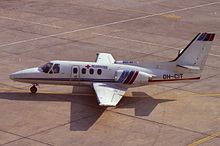
Cessna 500 Citation
The Cessna Citation 500 is a twin-engine light corporate jet produced by Cessna from 1972 until 1976. Model 500 seats up to 6 passengers and 2 pilots for Citation. The Citation has seating for up to seven passengers and two pilots.
Specifications
Exterior Dimensions (SN 1-70)
Wing span: 43 ft 9 in
Length: 43 ft 6 in
Height: 14 ft 3 in
Performance (SN 1-70)
| Horsepower: 2200.00 | Gross Weight: 10,850 |
| Top Speed: 350 kt | Empty Weight: 6,350 |
| Cruise Speed: 348 | Fuel Capacity: 3;618 |
| Stall Speed (dirty): 84 | Range: 1,064 |
| Rate of Climb: 2,900 | Rate of Climb (One Engine): 906 |
| Service Ceiling: 35,000 | Ceiling (One Engine): 21,000 |
| Takeoff | Landing |
| Ground Roll: | Ground Roll |
| Takeoff Roll Over 50 ft: 2,550 | Landing Roll Over 50 ft: 2,310 |
Exterior (SN 303 & up)
Wing span: 43 ft 11 in
Length: 43 ft 6 in
Height: 14 ft 4 in
Performance (SN 303 & up)
| Horsepower: 2200.00 | Gross Weight: 11,500 |
| Top Speed: | Empty Weight: 6,454 |
| Cruise Speed: 348 | Fuel Capacity: 3;780 |
| Stall Speed (dirty): 85 | Range: 1,308 |
| Rate of Climb: 2,900 | Rate of Climb (One Engine): 800 |
| Service Ceiling: 41,000 | Ceiling (One Engine): 18,300 |
| Takeoff | Landing |
| Ground Roll: | Ground Roll |
| Takeoff Roll Over 50 ft: 2,660 | Landing Roll Over 50 ft: 2,300 |
Engine
Manufacturer: Pratt & Whitney
Model: JT15D-1 (2) turbofan engines
Horsepower: 2200 lbs
Overhaul (HT): 3000/3500 TBO
History
The highly popular Cessna 500 Citation and 500 Citation I pioneered the entry level light business jet market, and their success formed the basis for the world's largest family of corporate jets. Cessna became the first of the big three American manufacturers (Piper, Beech and Cessna) to develop a jet powered transport. In October 1968 Cessna announced its plans to build a new eight place jet powered business aircraft that would be capable of operating into airfields already served by light and medium twins.
The Fanjet 500 prototype first flew on September 15, 1969, and soon after it was certified the new little jet was named the Citation. A relatively long development program followed, during which time a number of key changes were made to the design including a longer forward fuselage, repositioned engine nacelles, greater tail area and added dihedral to the horizontal tail.
In this definitive form the Citation was granted FAA certification on September 9 1971. Improvements including higher gross weights and thrust reversers were added to the line in early 1976, followed shortly after by the introduction of the enhanced Citation I? later that same year. Features of the Citation I were higher weights, JT15D-1A engines and an increased span wing.
Development
In October 1968 Cessna announced an eight place business jet capable of operating from light/medium twins airfields. The Fanjet 500 prototype first flew on September 15, 1969. The renamed Citation had a relatively long development program with a longer forward fuselage, repositioned engine nacelles, a larger tail, and more dihedral to the horizontal tail. It was FAA certified on September 9, 1971.
In early 1976, its wingspan grew from 43.9 to 47.1 ft. It also gained thrust reversers and higher gross weights. The enhanced Citation I was introduced later in 1976 with higher weights, JT15D-1A engines, and an increased span wing.
Design
The aircraft was powered by two Pratt & Whitney Canada JT15D-1 turbofan engines after Cessna's experience with the T-37 Tweet twinjet trainer. Turbofan rather than turbojets and straight wings rather than swept wings made it cruise slowly compared to other business jets and Learjet salesmen mocked it as the “Nearjet” vulnerable to “bird strikes from the rear”; Cessna renamed it the “Citation” after the thoroughbred but it was nicknamed as “Slowtation”.
Cessna originally used ARC analog radios in the Citation, but has since upgraded its avionics to modern digital technology. The jet is equipped with dual Collins VHF comms, VIR 30 navs, ADF 60’s, the Sperry APZ 500 autopilot and Bendix RDR 1100 radar. Although advancements and improvements have been made to models since the Citation, it still has a lot to offer in terms of performance. The Citation has a maximum payload of 2,097 lbs. Its maximum takeoff weight is 11,850 lbs. to reach a flight ceiling of 41,000 ft.

